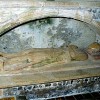“Lyme doesn’t pretend to be anything other than what it is: a quiet seaside resort with a small fishing and pleasure boat harbour. The hilly countryside above it is like parts of the Cotswolds. In many ways the place hasn’t changed in 1,200 years.”
The speaker grew up in Lyme Regis, which is nearly in Devon, and often does a three hours drive to get there for a week in a hotel. He reminded me that ships sailed to meet the Spanish Armada from Lyme, where a stone rampart sticks far out to sea at the Cobb.
So I had to see Lyme Regis.
Starting from the church, I walked down the hill and found myself outside the Pilot Boat Inn, where once the landlord’s dog gained fame by licking the face of an apparently drowned sailor and brought him back to life. The sailor was from the torpedoed battleship “Formidable,” which went down in the bay in 1915. It is a friendly place, but the bartender I spoke to knew nothing about the dog or the battleship, although the walls were lined with pictures of ships and even the tablemats have a nautical theme.
Outside again, among painted houses and too much traffic for comfort, I could tell where the beach was from the smell of the salt-laden air. So I strode out across the sand and shingle for the Cobb, to the west, the tiny port with a forest of masts and stout walls of Portland stone.
It is too shallow for larger shipping, but once it saw a trader loose her ropes and set sail for nearby Charmouth, anchoring in the bay to await King Charles II who was fleeing to France. The next part of the story may have originated in a local bar-room, but it is said the skipper’s wife, fearful of revenge by the Roundheads (for sympathies were with them here) locked him in his cabin so that he could not get to either anchor or wheel.
On the way to the Cobb I passed a few gay awnings, rows of electric bulbs, the odd hot-dog and ice-cream stalls, but nothing more ostentatious that that. Fifteen castles, mermaids and other marvellous creations from sand awaited the competition judges and people gingerly picked their way around them to admire.
Hereabouts are cannons pointing out to sea and a 10-foot anchor given by the former Portland Navy Base “in memory of Lyme Regis men and women who made their living from the sea.”
People were fishing off the sea wall for “flatties” and two boys from Seaton and Axminster emerged from the falling tide in wetsuits, intending to do some snorkelling on a full tide. And all the time a sea mist hung over the town above the beach – an indication, I was told, that Lyme was in for a hot period. “It always happens,” said the ice-cream lady. And so it was to prove.
Beyond the Cobb is a beach where the Duke of Monmouth came ashore with his men in 1685 to lead a revolt against King James on religious grounds, only to be defeated at the Battle of Sedgmoor in Somerset. A dozen of those men from Lyme who joined him were hanged where the inhabitants of the town could see their bodies. Very ugly. Worth comparing with violent times today.
The Old Watch House looks out over Lyme Bay – and now the mist lifted, revealing dramatically high cliffs along the coast to the east. Upper and lower promenades lead back to the town centre three quarters of a mile away. Once there, a little way back up the hill is the parish church of St.Michael the Archangel, with its centuries-old-Flemish-woven tapestry and its three-foot model of a lifeboat with sails and oars, circa 1925.
Only 20 yards beyond the east wall are the Church Cliffs, where the sea has eroded the land over the centuries. The cliffs have to be stabilised from time to time: the church itself goes back to Saxon times, when the building must have been far from the sea. The view on a fine day stretches from the Cobb to Golden Cap Cliff, and the Isle of Portland, a lady in the churchyard told me.
In the museum at the bottom of the hill I learned of the town’s decline as a port in the 19th and 20th centuries, after 600 years, as ships became larger. Yet even today it has a boat building yard. Passing through the town names like Marine Parade are seen, continuing the maritime theme.
Back on the beach I went for my second ice-cream, while people changed in tiny plastic beach tents to go into the sea, most only paddling. I saw no more than 30 people paddling and swimming at once along the whole beach. Then the sun came out again.
As it happened, it was Lifeboat Week, and parachute, helicopter, lifeboat and coastguard displays had been set out, with some spectacular flying by the RAF Red Arrows and even a tug o’war between coastguards and life boatmen. A smugglers tour, fireworks at sea, illuminated boats and a Yetties concert were designed to keep up the interest. The stage sound system belted out the decibels, and Lyme let its hair down.
“The Pearl of Dorset,” they call Lyme Regis. It hasn’t been commercialised as larger resorts have, yet it is not under-developed as a coast attraction like the neighbouring seaside place of Bridport’s West Bay is. Lyme was on a major Roman road, was a besieged Roundhead fortress, and 50 years ago was described as “a quaint old-world place nestling at the foot of the hills.” I don’t think my friend from the Cotswolds would disagree with a word of that.
Here we are on the Jurassic Coast, with outstanding geology attracting people with hammers: world famous fossil-hunting country and the South West Coast Path. Here is a fully restored working water-mill, and Gun Cliff, where artillery once sent away a raiding ship with a single shot.
Besieged in 1644, it is peaceful today with galleries, cafes, craft and antiques shops. Yes, the “Pearl of Dorset,” everyone seems to agree.



